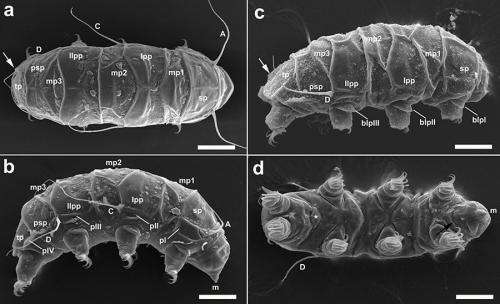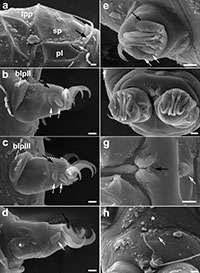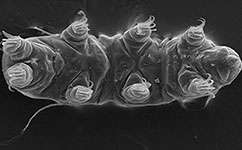Electron microscope images of the new tardigrade.
It's a member of the tardigrade family. Also known as water bears or moss piglets, these are widespread and ancient microscopic animals, around half a millimetre long at most and generally found in moss and lichen, where they eat plant cells or small invertebrates.
Members of the group are found everywhere from high mountains and hot deserts to the deep ocean. Their success stems partly from the fact they're among the toughest creatures we know of, able to deal with extremes of cold, heat, pressure, dehydration, poison and radioactivity that would kill almost anything else – indeed, they are the only kind of animal that we know can survive in the vacuum of space.
Researchers led by Dr Roberto Guidetti from the University of Modena and Reggio Emilia in Italy found the new creature while on a trip to Victoria Land. It was lurking on lake-shore mosses within the Crater Cirque, a natural bowl hollowed out by ancient glaciers.
Dr Sandra McInnes, a tardigrade specialist at the British Antarctic Survey, was enlisted to help classify the find. Examination under an electron microscope revealed various unusual features – for instance the red-orange creature has tiny pads or cushions behind its claws, and a distinctive pattern of hairs on its body – suggesting the scientists were dealing with a new species. We don't yet know what these features are for, or how they benefit the animal.
The researchers combined this traditional approach to taxonomy by examining the organism's physical form with modern molecular methods, sequencing its DNA and using the results to work out the tardigrade's evolutionary lineage. The genetic analysis confirmed that it's a new species within the genus Mopsechiniscus – the researchers named in Mopsechiniscus franciscae.
Details of the new tardigrade.
Going back to the forebears
This is the furthest south a member of this genus has ever been found, extending its range into Antarctica for the first time. It was already known to be present in large swathes of South America – all the way down the Andean mountain chain to Tierra del Fuego – in Tasmania, and in South Georgia. But although it's found on several continents, it seems to need quite specialised kinds of habitat – it's common only in a few specific areas in each. 'It doesn't seem to travel well,' McInnes notes. 'It's quite an unusual genus to find a new member of, particularly in Antarctica where there are relatively few good tardigrade habitats.'
Electron microscope image of a new tardigrade.
The discovery of the genus in Antarctica adds to the evidence that it's an old lineage descended from forebears that were present on the ancient supercontinent of Gondwana, and that it has changed relatively little since then compared to other tardigrade genera.
'Mopsechiniscus is unique among tardigrades, as our molecular analysis shows,' McInnes says. 'The genus has a lot of more primitive characteristics that suggest it is closer to the group's more distant ancestors.'
The discovery is published in Polar Biology.
More information: "Mopsechiniscus franciscae, a new species of a rare genus of Tardigrada from continental Antarctica." Polar Biology, April 2014. DOI: 10.1007/s00300-014-1514-x
Provided by PlanetEarth Online
This story is republished courtesy of Planet Earth online, a free, companion website to the award-winning magazine Planet Earth published and funded by the Natural Environment Research Council (NERC).


























